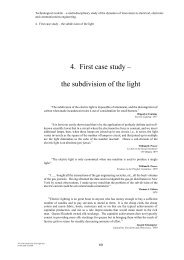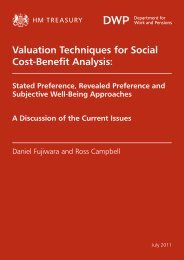NAO Good Practice Guide - Tackling external fraud - HM Treasury
NAO Good Practice Guide - Tackling external fraud - HM Treasury
NAO Good Practice Guide - Tackling external fraud - HM Treasury
Create successful ePaper yourself
Turn your PDF publications into a flip-book with our unique Google optimized e-Paper software.
<strong>Good</strong> practice in tackling <strong>external</strong> <strong>fraud</strong> | Understanding and managing the risks of <strong>fraud</strong><br />
1.2 In taking a strategic approach, some<br />
departments and agencies have taken an across<br />
the board approach to looking at <strong>external</strong> <strong>fraud</strong>,<br />
and some have looked at individual <strong>fraud</strong> risks<br />
and produced a strategy for each. Others tackle<br />
<strong>fraud</strong> within the context of an overall strategy to<br />
combat losses from all types of non-compliance.<br />
The overall compliance approach recognises that<br />
there is a ‘loss continuum’ ranging from inadvertent<br />
customer error at one end of the spectrum to <strong>fraud</strong><br />
at the other with shades of grey in between<br />
Figure 5<br />
Examples of counter <strong>fraud</strong> strategies<br />
The Department for Work and Pensions<br />
has developed a counter <strong>fraud</strong> strategy for<br />
all welfare benefits. First set out in 1999,<br />
the strategy proposed action on four fronts:<br />
l Getting it right – aiming to get benefit<br />
payments correct from day one;<br />
l Keeping it right – ensuring payments<br />
are adjusted as circumstances change;<br />
l Putting it right – detecting when<br />
payments go wrong and taking prompt<br />
action to correct them with appropriate<br />
penalties to prevent a recurrence;<br />
l Making sure the strategy works<br />
– by monitoring progress, evaluating<br />
the strength of preventive measures<br />
and adjusting them in the light of<br />
experience.<br />
The Department seeks to ensure that their<br />
goals of supporting people in their efforts<br />
to find work, whilst providing appropriate<br />
financial support where necessary, are not<br />
compromised by their efforts to prevent<br />
<strong>fraud</strong>ulent abuse of the benefits system.<br />
The NHS Counter Fraud Service’s<br />
strategy consists of seven objectives:<br />
l the creation of an anti-<strong>fraud</strong> culture;<br />
l maximum deterrence of <strong>fraud</strong>;<br />
l successful prevention of <strong>fraud</strong> which<br />
cannot be deterred;<br />
l prompt detection of <strong>fraud</strong> which<br />
cannot be prevented;<br />
l professional investigation of<br />
detected <strong>fraud</strong>;<br />
l effective sanctions where <strong>fraud</strong><br />
is proven;<br />
l redress for money de<strong>fraud</strong>ed.<br />
<strong>HM</strong> Revenue and Customs’<br />
approach to tackling <strong>fraud</strong> has a<br />
number of key components:<br />
l the development of reliable<br />
estimates of the size of tax losses<br />
as far as possible;<br />
All of these approaches can be equally valid<br />
depending on a department’s circumstances and<br />
the stage they are at in developing their approach<br />
(Figure 5). However, a common feature is that<br />
the departments and agencies develop <strong>fraud</strong> risk<br />
assessment tools to identify the <strong>fraud</strong> risks, their<br />
likelihood and impacts, and how to manage them.<br />
These tools need to be reviewed regularly to assess<br />
whether they remain appropriate or require updating<br />
to respond to the threat from new <strong>fraud</strong> risks.<br />
l establishing the nature and economics<br />
of the activity and behaviour that cause<br />
the losses, through the analysis of<br />
intelligence and other data;<br />
l a comprehensives set of responses<br />
based on:<br />
1 Support: building services that<br />
are tailored to the needs and<br />
circumstances of taxpayers;<br />
2 Prevention: ensuring that basic<br />
processes and design make the<br />
system as secure as possible from<br />
<strong>fraud</strong> and avoidance;<br />
3 Identifying and tackling those<br />
who set out to obtain an unfair<br />
tax advantage: using improved<br />
risk assessment and checks, with<br />
sanctions as appropriate tailored<br />
to behaviour.<br />
l Monitoring effectiveness against key<br />
outcomes to measure the success of<br />
the strategies.





![AIRTO [Professor Dr Brian Blunden] - HM Treasury](https://img.yumpu.com/15492848/1/184x260/airto-professor-dr-brian-blunden-hm-treasury.jpg?quality=85)










